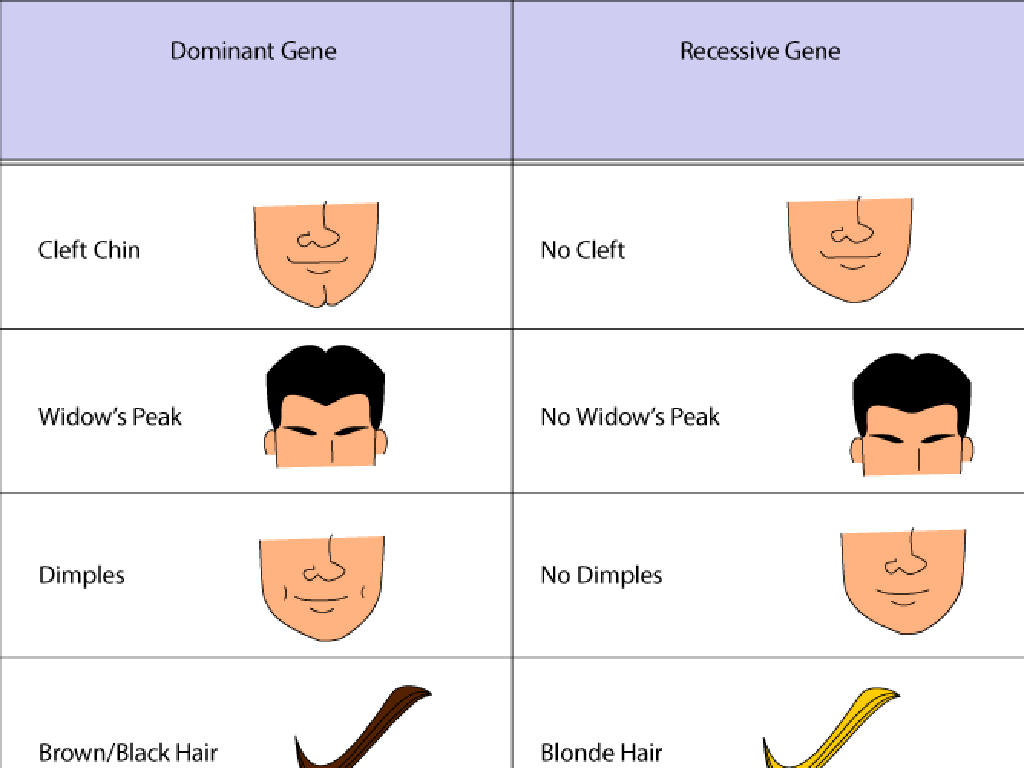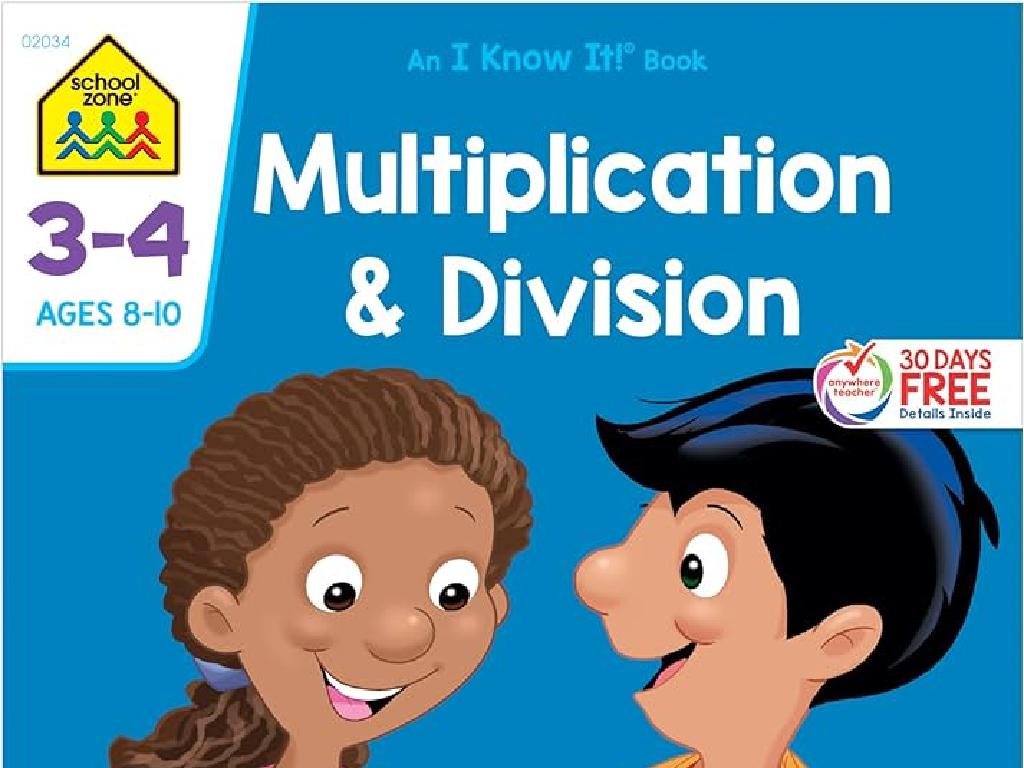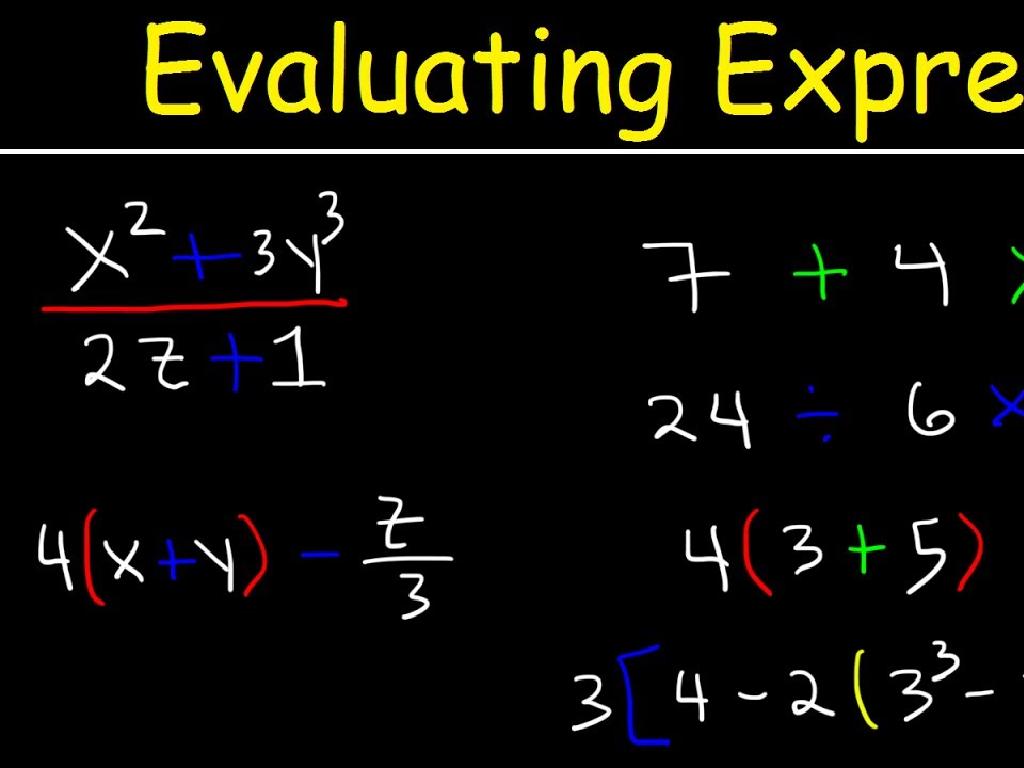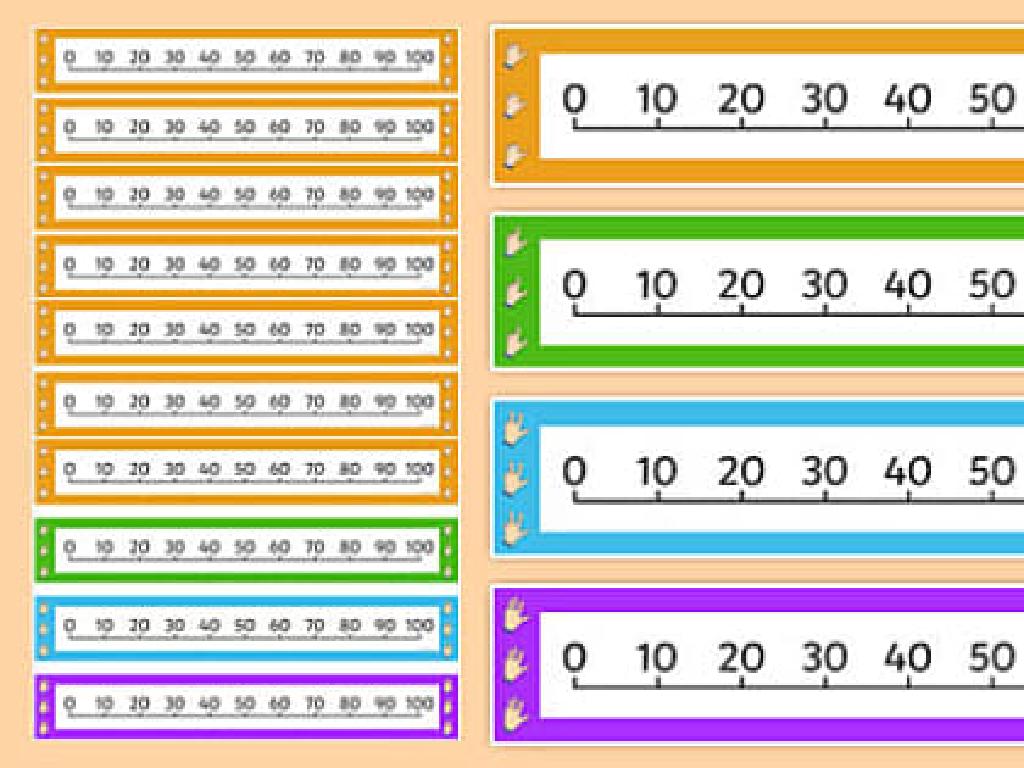Division With Decimal Quotients: Word Problems
Subject: Math
Grade: Fifth grade
Topic: Divide Decimals
Please LOG IN to download the presentation. Access is available to registered users only.
View More Content
Mastering Decimal Division Through Word Problems
– Understanding decimal division
– Division involving numbers with decimals
– Real-world decimal applications
– Examples: money, measurements
– Solving decimal division problems
– Use word problems to find decimal quotients
– Today’s goal: Decimal quotient mastery
|
This slide introduces students to the concept of dividing numbers with decimals, which is a vital skill in mathematics, especially as it applies to real-life situations like handling money or taking measurements. The objective is to help students feel comfortable with decimal division through the context of word problems, which can aid in their understanding of how decimals are used in everyday life. Encourage students to think of situations where they have encountered decimals outside of school. The goal for today’s lesson is for students to become proficient in solving word problems that result in decimal quotients, preparing them for more complex mathematical concepts.
Recap: Understanding Division
– Review of division fundamentals
– Division: sharing or grouping
– If 12 cookies are shared among 4 friends, how many does each get?
– Key division terms
– Dividend is what you divide. Divisor is by what you divide. Quotient is the result.
– Handling remainders
– Sometimes division doesn’t divide evenly, that’s a remainder.
|
This slide is a quick recap of the basic concept of division, aimed at refreshing the students’ memory before diving into division with decimals. Start by reviewing what division is and how it can be thought of as either sharing or grouping objects equally. Introduce the vocabulary associated with division: dividend (the number being divided), divisor (the number you are dividing by), quotient (the result of division), and remainder (what is left over if the division isn’t exact). Use simple examples to illustrate these concepts, such as dividing a set number of cookies among a group of friends. Emphasize that understanding these terms is crucial for solving more complex problems involving decimals.
Introduction to Decimals in Division
– Understanding decimals
– Decimals represent fractions of a whole, like 0.5 is half.
– Decimals in daily life
– Money uses decimals: $1.50, measurements: 3.2 cm, etc.
– Place value in decimals
– Each position in a decimal number has a value, like tenths, hundredths.
– Significance of place value
|
This slide introduces the concept of decimals, which are a fundamental part of division when dealing with non-whole numbers. Start by explaining that decimals are a way to express fractions and that they are used frequently in everyday life, especially in money and measurements. Emphasize the importance of place value, which helps us determine the value of each digit in a decimal. Understanding place value is crucial when dividing decimals to ensure accuracy in calculations. Provide examples and encourage students to think of other areas where they encounter decimals. This foundational knowledge will be important for solving word problems involving decimal division.
Dividing Whole Numbers by Decimals
– Steps to divide by a decimal
– Move the decimal point in both numbers, then divide as with whole numbers.
– Example: 50 ÷ 0.5
– 50 becomes 500, and 0.5 becomes 5. Now divide 500 by 5 to get 100.
– Class practice problem
– Let’s solve a problem together as a class.
|
This slide introduces the concept of dividing whole numbers by decimals. Start by explaining the process of moving the decimal point to the right in both the divisor and the dividend until the divisor is a whole number. Emphasize that the same number of places must be moved for both to keep the equation balanced. Use the example of dividing 50 by 0.5 to illustrate this, showing step by step how 50 becomes 500 and 0.5 becomes 5, making it a simpler division of 500 ÷ 5 = 100. After explaining the example, engage the class with a practice problem, guiding them through the steps and encouraging them to try it on their own or in small groups. This hands-on activity will help solidify their understanding of the concept.
Dividing Decimals by Whole Numbers
– Steps to divide a decimal by a whole number
– Place the decimal point in the quotient directly above its position in the dividend.
– Example: 2.5 ÷ 5
– 2.5 divided by 5 equals 0.5. Place the decimal point directly above in the answer.
– Class practice problem
– Solve 3.6 ÷ 4 together as a class.
|
This slide introduces the concept of dividing decimals by whole numbers. Start by explaining the process step-by-step, ensuring to highlight the importance of aligning the decimal point in the answer with the decimal in the dividend. Use the example of 2.5 ÷ 5 to illustrate this concept clearly, showing the students how the decimal point is placed in the quotient. Then, engage the class with a practice problem, such as 3.6 ÷ 4, to solidify their understanding. Walk through the problem with the class, asking for volunteers to solve it step-by-step. This interactive approach helps students apply the concept and prepares them for similar problems in their homework.
Dividing Decimals by Decimals
– Steps to divide decimals
– Align the decimals, then multiply divisor and dividend by 10 until there are no decimals
– Example: 3.75 ÷ 1.5
– 3.75 becomes 375 and 1.5 becomes 15. Now divide 375 by 15 to get 25
– Class practice problem
– Solve 4.8 ÷ 1.2 together as a class
|
This slide introduces the concept of dividing decimals by decimals. Start by explaining the process of aligning the decimals and multiplying both the divisor and dividend by the power of 10 needed to make the divisor a whole number. Use the example of 3.75 divided by 1.5 to illustrate this process, showing step by step how to convert it into a simpler division problem of 375 divided by 15. After walking through the example, engage the class with a practice problem, such as 4.8 divided by 1.2, and solve it together. Encourage students to ask questions and discuss any difficulties they encounter. The goal is to ensure they understand the method and can apply it to different problems.
Division with Decimal Quotients: Word Problems
– Carefully read the problem
– Find numbers and their meaning
– For example, if ‘miles’ or ‘cost’ are mentioned, what do these numbers represent?
– Choose the right operation
– Is it asking to split something into parts? That means division.
– Solve and verify your answer
– Use estimation to check if your answer makes sense.
|
This slide is aimed at guiding students through the process of solving word problems involving division with decimal quotients. Emphasize the importance of understanding the problem by reading it carefully and looking for keywords that indicate division. Students should practice identifying the numbers in the problem and understanding what they represent, such as distance, money, or quantity. Teach them to decide whether to divide based on the context of the problem. After solving, students should check their work by estimating and seeing if their answer is reasonable. Provide several practice problems and go through them as a class to reinforce these strategies.
Solving Decimal Division Word Problems
– Example: Pizza party division
– If 3 friends share 2 pizzas equally, how much does each get?
– Class works through the problem
– Use whiteboard to solve together, step by step
– Discuss various solving methods
– Long division, estimation, and using multiplication
– Emphasize understanding, not just answers
|
Begin with a relatable word problem involving decimal division to capture the students’ interest. For example, dividing pizzas among friends. Work through the problem as a class, encouraging participation and demonstrating the steps on the whiteboard. Discuss different methods to solve the problem, such as long division, estimation, and checking work by multiplication. Emphasize the importance of understanding the process and logic behind the solution, rather than just finding the answer. This will help students apply these skills to various problems and enhance their critical thinking.
Independent Practice: Division with Decimals
– Solve decimal division problems
– Discuss methods with classmates
– Share your problem-solving steps
– Seek teacher’s help if needed
– Don’t hesitate to ask for hints or explanations
– Practice makes perfect!
|
This slide is designed for students to apply their knowledge of dividing decimals through independent practice. Students should attempt to solve the problems on their own, which will help reinforce their understanding of the concept. Encourage them to discuss their problem-solving strategies with peers, as this can provide different perspectives and methods. While they work, circulate the room to offer support and answer questions. Remember to praise effort and correct reasoning as much as correct answers. For the teacher’s reference, prepare a list of potential word problems varying in difficulty, and consider having hints or step-by-step guides ready for students who may struggle more than others.
Class Activity: Decimal Division Relay
– Form teams for the relay
– Each team gets a word problem
– Problems involve dividing numbers with decimals
– Solve the decimal division problem
– Use long division method for accuracy
– First correct answer wins a point
|
This activity is designed to encourage teamwork and quick thinking as students apply their knowledge of decimal division to solve word problems. Divide the class into small groups, ensuring a mix of abilities in each team to promote peer learning. Each team will receive a word problem that requires them to divide decimals. The problems should be of similar difficulty and structured to challenge their understanding of the concept. The first team to present a correct solution earns a point for their team. Keep the energy high and provide immediate feedback. Possible variations of the activity could include a mix of easier and more challenging problems, a relay format where each student solves a step, or a ‘sudden death’ round for an extra challenge.
Review and Reflection: Decimal Division
– Recap of decimal division
– Effective strategies discussion
– Which methods helped you solve problems faster?
– Real-life application of decimals
– Consider how shopping or banking uses decimal division
– Reflect on today’s learning
|
As we wrap up today’s lesson on decimal division, it’s crucial to review the key concepts to ensure understanding. Encourage students to discuss the strategies they found most helpful, such as estimating or using place value. Highlight the importance of decimal division in everyday life, like when dealing with money or measurements. Ask students to think about how they used decimal division today and how it relates to real-world scenarios. This reflection helps solidify their learning and appreciate the value of the math skills they’re acquiring.
Homework and Next Steps: Division Mastery
– Practice with decimal division problems
– Solve assigned word problems involving decimal division.
– Preview: Multiplying Decimals
– Get a sneak peek at how decimals are multiplied.
– Utilize online resources for practice
– Explore educational websites for additional exercises.
– Bring questions to next class
|
For homework, students should complete the set of decimal division word problems to reinforce today’s lesson. Encourage them to approach these problems methodically, showing all their work step by step. Looking ahead, give students a brief introduction to multiplying decimals to pique their interest for the upcoming lesson. Recommend specific online resources where students can find extra practice problems to further solidify their understanding of decimal division. Remind them to bring any questions or difficulties they encounter to the next class for clarification. This will ensure they are well-prepared and confident in their decimal division skills.






